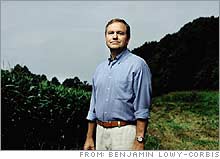Thursday, September 28, 2006
 Regarding compact fluorescent lightbulbs, Fast Compnay Magazine had this great article to say:
Regarding compact fluorescent lightbulbs, Fast Compnay Magazine had this great article to say:In the energy business, it is called a "CFL," or an "energy saver." One scientist calls it an "ice-cream-cone spiral," because in its most-advanced, most-appealing version, it looks like nothing so much as a cone of swirled soft-serve ice cream.
If every one of 110 million American households bought just one CFL bulb, took it home, and screwed it in the place of an ordinary 60-watt bulb, the energy saved would be enough to power a city of 1.5 million people. One bulb swapped out, enough electricity saved to power all the homes in Delaware and Rhode Island. In terms of oil not burned, or greenhouse gases not exhausted into the atmosphere, one bulb is equivalent to taking 1.3 million cars off the roads.
That's the law of large numbers--a small action, multiplied by 110 million.
The single greatest source of greenhouse gases in the United States is power plants--half our electricity comes from coal plants. One bulb swapped out: enough electricity saved to turn off two entire power plants--or skip building the next two.
Swirl bulbs don't just work, they pay for themselves. They use so little
power compared with old reliable bulbs, a $3 swirl pays for itself in lower
electric bills in about five months. Screw one in, turn it on, and it's not just
lighting your living room, it's dropping quarters in your pocket. The advantages
pile up in a way to almost make one giddy. Compact fluorescents, even in heavy
use, last 5, 7, 10 years. Years. Install one on your 30th birthday; it may be
around to help illuminate your 40th.
Read on. Are you sold now?
posted by Michael Tavani at 12:25 PM |
0 comments
|
0 comments





